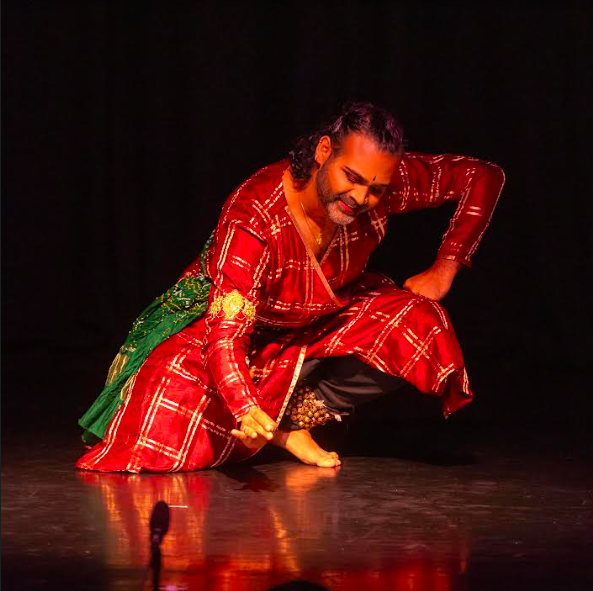Dhārā – Shyam Nayan
Dhārā
Shyam Nayan
Bhavan, London,
31 August 2024
Reviewed by Pranav Yajnik
Photo: Vipul Sangoi
In these latter days of kathak, we can no longer rely on the gharana as the indication of how a dancer will dance. Perhaps it was true, even only fifty years ago, that lineage and tradition were the major determinants of style and approach, but those lines have since faded. Now, on the one hand, many dancers sit comfortably astride all the gharanas performing compositions from each with a generalised style of movement; on the other hand, the gharanas themselves have changed: some of Jaipur and Banaras’ showmanship has reached Lucknow perhaps; perhaps some of Lucknow’s polish has infected Jaipur and Banaras. And yet, certainly in the United Kingdom at least, it’s rare for students raised in one style actively to seek opportunities to expose themselves to other styles, to find the beauty in them and from them to learn what they can. We may be scared of an uncomfortable learning or viewing experience; but it’s only when we’re pushed out of our comfort zones, that we adapt and change and ultimately grow. Without the discomfort of the new, there’s stagnation; where there’s stagnation, there’s no progress.
So it was with interest and some expectation that I went to watch Shyam Nayan’s performance, who presented a traditional kathak repertoire in the the Kundanlal Gangani style of Jaipur Gharana. He opened the night with Rangīlā Shambhu, a folk bhajan of Rajasthan. A corresponding touch of folk in the choreographic movements effectively combined with the music to create an honest piece that had a lot of integrity. Following this was the substantial part of the performance: the tīntāl technical section. Nayan offered an abundance of compositions in the Jaipur style, from the signature gliding thāT and the punchy uThāns to extended parans and play with the sub-divisions of the rhythm. It really brought home to me (as a dancer mostly in the Lucknow style) how impoverished Lucknow is when it comes to the varieties and combinations of rhythmic patterns which are commonly used for its compositions: Nayan’s piece brimmed with an uncommon bounty of rhythmic patterns of every description. Not only that, they freely incorporated changes of jati (units of rhythm) in unexpected and novel ways. Nayan had clearly worked hard in preparing for the night and his technical expertise was well up to the demands of his compositions, with spins executed with power and footwork that was clear and confident. If there was a note to make, Nayan could easily afford to remain a moment or two after each sam in pose to let the compositions resonate more with the audience before moving on to the next.
An abhinaya presentation as the third item foregrounded the musical accompaniment, which was excellent. Nayan performed abhinaya first on his own text, followed by verses from Jayadeva’s Gīt Govinda. The technical prowess in the rest of the performance resulted in the abhinaya section – although executed competently – feeling somewhat underpowered by comparison. It could be that changes to the lighting and structure of the music would ensure that the piece lands with the bite that it needs. Nayan’s last item was a tarānā in rāg Bāgeshrī which served as a recapitulation of the technical aspect of the performance and a positive finish to the show.
Nayan seemed very at home on the stage, with an easy manner at the microphone. In these days of high-concept choreographies and everyone thinking we need to make ‘art’, Dhārā was a refreshing reminder that art can make itself if one performs with the skill and competence to bring it out, and that is enough. I look forward with anticipation to more of Nayan’s performances and being reminded again what kathak has been, and what it still is.




















